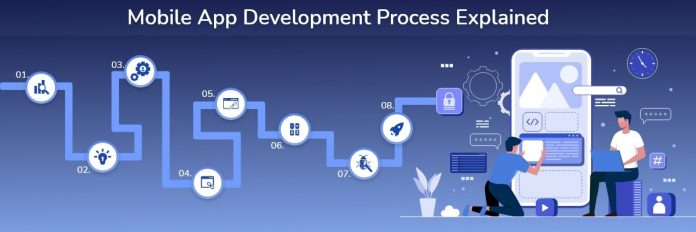Thousands of applications are published on the Google and Play Store daily. As of today, there are an estimated 2.59 million apps placed on Play Store and 1.96 million apps on Apple Store.
If you are an aspiring mobile app developer who dreams to work for a reputable mobile app development company, you would love to have a peek at the whole development cycle.
This article will walk you through the mobile app development process right from start.
Mobile App Development Process
Here are 6 fundamental steps involved in the app development process:
1. Idea
An interesting idea is the first thing that encourages the investor to build a mobile app. Generally, such ideas are conceived with the aim to solve a particular problem or simplify a process.
Today, we have mobile apps available that monitor your sleep, count your daily steps, keep a track of your daily calories, assist in appliance control, and so on. Of course, someone devised an interesting idea in the beginning, and later other people followed after its success.
2. Market Research
Then comes the tricky part, figuring out if your idea is viable or not. You see, there are thousands of applications available for the same task.
For instance, if you want to create a food delivery app, you will be competing against at least dozens of giant companies. Likewise, if you want to create an app for health monitoring, there are already thousands of them.
So if you step into a niche that is already saturated, you will meet fierce competition. And building a reputation will be a herculean task.
3. Creating Wireframes
Wireframing is another crucial part of the development process. Once you have done the brainstorming part and jotted down all the essential requirements, you move forward to create a wireframe.
A wireframe is like a pillar of the mobile application or website. It depicts the flow of the system and gives a rough idea of how the system would function. So before the final product is ready, you know what it will look like.
A wireframe also helps in estimating the development timeline. When you are creating an app for a client, the timeline is part of the contract. Without the wireframe, it would be impossible to estimate how much time a particular app will take to complete.
4. UX/UI Design
Once you have agreed on the architecture of your app and the functionalities it will have, you move on to the design part. Designing a UX/UI is not just a creative job but requires a lot of research.
A UX/UI can make any online business. Several studies conducted in this domain show that every dollar invested in UX brings $100 in return on average. These numbers reflect the impact of a well-designed UX/UI on your app.
It can make or break your business. So when developers and designers sit down, they discuss every aspect of the User Experience before implementing any suggestions.
5. Development/Coding
And here begins the coding phase. You have a design ready, and you know what functionalities you are supposed to design, so all that is left now is to code your application.
Just like website development, mobile application development is divided into two parts: Front-end development and back-end development.
The term front-end development refers to coding the user interface, the button, menu, and all the elements an ordinary user sees at the front. Every user interacts with the front of the app, what happens at the back is not their concern.
Likewise, back-end development refers to the coding of the functionalities. All the capabilities of an application are coded.
The technology stack you can choose depends on the operating system for which you want to create an app. Some applications are native – exclusively designed for either Android or iOS devices – while some run on both.
6. Testing
Routine testing goes parallel with the app development process. It’s vital to test every aspect of the front and back end while the app is being coded. This way, the detected bugs are solved in parallel, instead of being left for the end.
The whole testing phase can be divided into the following steps:
- Functional Testing
- Usability Testing
- Performance Testing
- Fit and Finish Testing
- Regression Testing
- Device-Specific Testing
- User Acceptance Testing
Improper testing leads to a disaster. Imagine finding a bug in your app just when you are about to deploy it on Apple or Google Play store. And you can’t leave it for the future because this single bug can cause rejection from the platform.
Nowadays we have automatic testing tools available. These tools test the app without any supervision, identify the bugs, and even solve them. All you have to learn is to properly use them.
Final Words
Mobile app development is not something you can learn overnight. Likewise, the process is not as simple as it sounds to be, there are tons of complexities involved. So if you wish to acquire practical experience, we recommend you get some hands-on experience by taking on some app development projects.







